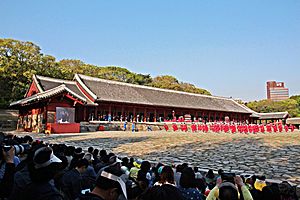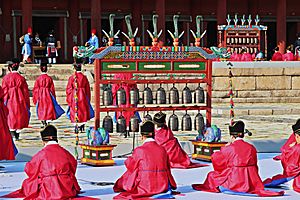Jongmyo facts for kids
Jongmyo Shrine is a very important religious building in Seoul, South Korea. It was built a long time ago, during the Joseon Dynasty (a kingdom that ruled Korea for over 500 years). Jongmyo is a "Confucian" shrine, which means it follows the ideas of a wise teacher named Confucius. It was first built in the late 1300s. Sadly, it was destroyed during a Japanese invasion in the 1500s, but it was rebuilt in the 1600s. Even today, people still use this special place.
Contents
Honoring Kings and Queens
Jongmyo Shrine is a place where people honor past kings and queens. Inside, there are special wooden tablets called "spirit tablets." Each tablet is for a specific king or queen from the Joseon Dynasty.
Confucianism teaches that it's important to respect your ancestors (family members who lived before you). This is called "ancestor worship." During the Joseon Dynasty, the king of Korea would visit Jongmyo. He would pray to the earlier kings and queens. There were also bigger ceremonies, called "rites" or "rituals," with many people. Some of these rituals included singing and dancing. It's amazing that some of these same rituals are still performed today!
Shrine Buildings and Layout
The way Jongmyo Shrine was built is very special. Its design works perfectly with the hills and nature around it.
The shrine has a main building called Jeongjeon. There's also a smaller shrine named Yeongnyeongjeon, which means "the Hall of Eternal Peace." The shrine also has a special area just for the king. There's a building to store items used in rituals. Plus, there's a waiting area for people. You can also find a shrine dedicated to King Kongmin. He was a king from an earlier kingdom called the Goryeo Dynasty. King Taejo, who started the Joseon Dynasty, built that shrine.
The Royal Shrine Ritual
The most important ceremony at Jongmyo was the Jongmyo-Daejae, or "Royal Shrine Ritual." During the Joseon Dynasty, this ritual happened five times every year.
However, during the time when Japan ruled Korea (from 1910 to 1945), this ritual was stopped. The Japanese rulers did not allow it. Since 1969, a group called the Royal Family Association has performed the Jongmyo-Daejae once a year.
Both the Jongmyo-Daejae ritual itself and the special music played during it are very important. In 2001, UNESCO declared them "Intangible Cultural Heritage." This means they are valuable traditions that should be protected.
A World Heritage Site
Because of its history and importance, Jongmyo was named a UNESCO World Heritage Site in 1995. This means it's considered a very special place for everyone in the world.
Images for kids




